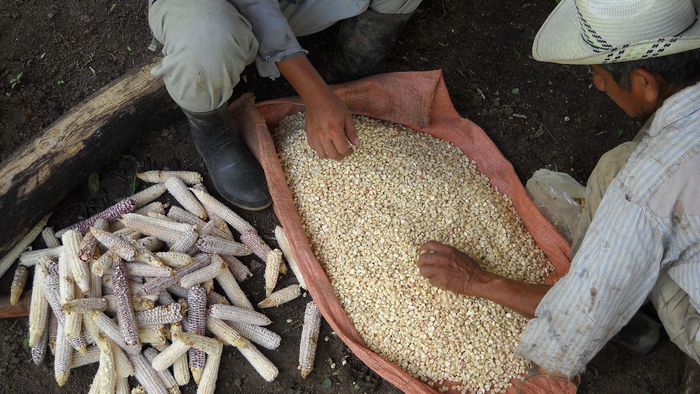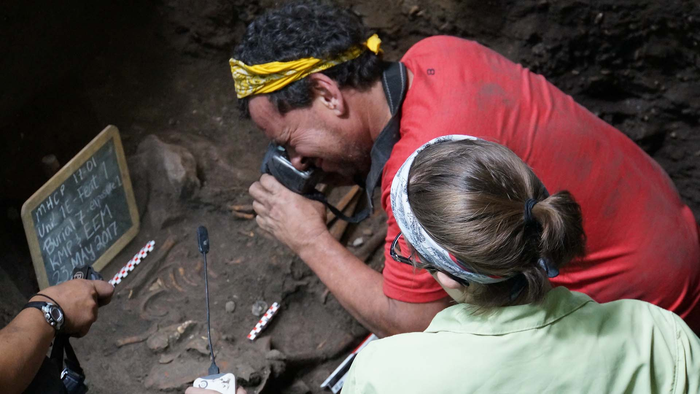Research published by University of New Mexico archaeologist Keith Prufer examined a site in Belize to study the origins of the ancient Maya people and the spread of maize as a staple food. It showed, in part, that Maya ancestors came from the south.
According to the paper, “South-to-north migration preceded the advent of intensive farming in the Maya region,” published this week in the journal Nature Communications and co-led by Prufer, excavations in Belize, along with ancient DNA analysis, indicate a previously unknown migration of people carrying maize from an area of South America northward to the Maya region.

Prufer and his colleagues excavated 25 burials dating from 10,000 to 3,700 BP from two cave and rock shelter sites located in the remote Maya Mountains of Belize. These sites are located below the overhang of tall limestone cliffs that sheltered the people living below and protected the deposits of the everyday debris and burials of the dead for over 7,000 years.
Maya ancestors migrated north around 5,600 BP
The excavated skeletons revealed a range of ancient DNA information on the movements of early populations in the Americas: An early southward migration of people from the north 9,600 to 7,300 BP show only distant relatedness to present-day Mesoamericans, including Maya-speaking populations. Then, a previously unknown movement from the south starting about 5,600 BP made a major demographic impact on the region, contributing more than 50 percent of the ancestry of all later individuals. This new ancestry derived from a source ancestral to present-day Chibchan speakers living from Costa Rica to Colombia, according to Prufer, whose lab led the archaeological and isotope research.
The genetic prehistory of human populations in Central America is largely unexplored, leaving an important gap in our knowledge of the global expansion of humans, which is why this research is really exciting and ground-breaking, Prufer remarked.
Poor preservation of ancient skeletal material in the hot and humid neotropics means that little is known about Early and Middle Holocene (10,000–4000 cal. BP) population history of southeastern Mexico and northern Central America.

According to the study, the excavations and DNA analysis support a scenario in which Chibchan-related horticulturalists moved northward into the southeastern Yucatan carrying improved varieties of maize, and possibly also manioc and chili peppers, and mixed with local populations to create new horticultural traditions that ultimately led to more intensive forms of maize agriculture much later in time.
“We see the migration of these people as fundamentally important for development of farming and, eventually, large Maya speaking communities,” Prufer said, noting that maize provided essential protein and sugar energy, and could be stored in a dry place. Once people had a reliable source of food in maize, they tended to farm and stay in one place, leading to larger, established communities.
Maize wasn’t always important to the Maya
Maize wasn’t always an important part of the diet of these people, Prufer said. The earliest migrants likely gathered and ate the tiny cobs of a grass known as teosinte, as well as the earliest maize domesticates, even though the cobs were very small, along with other plants, shellfish, and game. By selecting the biggest and best seeds, they began to domesticate the plant, growing larger cobs, and increasingly altering the landscape and biodiversity, a process that likely occurred largely in South America.
Eventually, the consumption of maize grew until it became a diet staple, much like the Europeans used wheat, Prufer said. The dispersal of maize grew, moving from the south, northward to the Maya population, and eventually across both continents so that when the Spanish arrived around 1500 AD, maize, or corn, was a staple of every Native American group’s diet.
The study’s authors are Douglas J. Kennett, Mark Lipson, Prufer, David Mora-Marín, Richard J. George, Nadin Rohland, Mark Robinson, Willa R. Trask, Heather H. J. Edgar, Ethan C. Hill, Erin E. Ray, Paige Lynch, Emily Moes, Lexi O’Donnell, Thomas K. Harper, Emily J. Kate, Josue Ramos, John Morris, Said M. Gutierrez, Timothy M. Ryan, Brendan J. Culleton, Jaime J. Awe, and David Reich.




